John William Sterling and James Orville Bloss, 1870-1918
"An Understanding...Held Them Together"
by Jonathan Ned Katz. Copyright (c) by Jonathan Ned Katz 2008. All rights reserved.
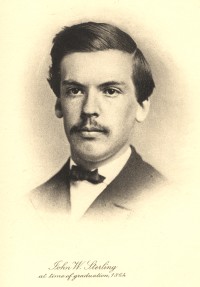
In 1864, John William Sterling graduated from Yale College. About 1870, in his mid-twenties, Sterling met James Orville Bloss, who was three years younger. The two formed a relationship of almost 50 years, and lived together in New York City for most of that time. What kind of relationship was this? Answering that question is a work in progress.
Garver Struggles to Understand
Sterling's biography was written by his law partner and friend, John Anson Garver (Yale, 1875), and published by Yale as a tribute in 1929. In it, Garver struggles to understand the Sterling-Bloss intimacy: "Mr. Sterling never married," says Garver, "but soon after his admission to the bar [in 1867], he formed the acquaintance of a young cotton broker about his own age, Mr. James O. Bloss...."[2]
The "but" in Garver's sentence makes Sterling's aquaintance with Bloss analogous to and substitute for a traditional marriage.
Garver adds: "Like Mr. Sterling," Bloss "never married; and the two lived together for the remainder of their days, with widely different tastes and yet with an understanding that held them together for nearly fifty years."[3]
Garver's reference to the friends' "understanding" that "held them together" suggests a special intimacy. He knew them well, apparently, and their "widely different tastes" surprised him.
Garver also refers to Bloss as Sterling's "chum for many years," the term "chum" also suggesting a special intimacy -- Garver does not use chum" about any other Sterling friend.[4]
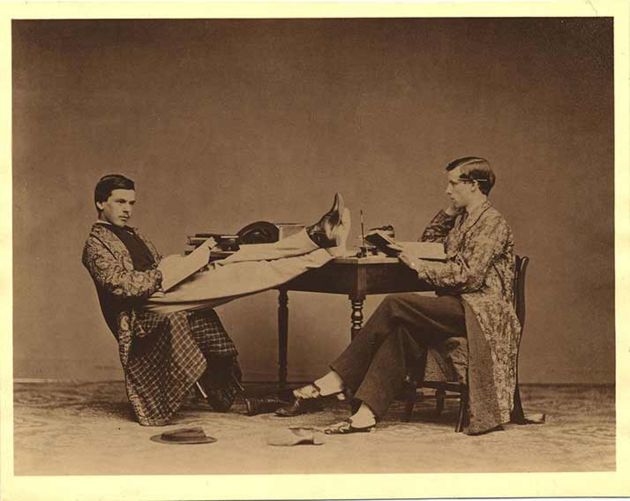
In his biography, Garver feels it necessary to explain what he considers Sterling's failure to marry and reproduce:
The emotional side of his nature did not have the usual outlet through domestic and family ties. Possibly, as the result of some youthful romance, he remained throughout his life indifferent to the charms of women and rarely allowed himself to be drawn into social functions of any kind.[6]
Sterling's indifference "to the charms of women" did not register with Garver as a failure, specifically, of "heterosexuality." Neither was Sterling's indifference to women perceived as a problem, specifically, of "homosexuality." Sexual desire was not at issue for Garver. Romance and marriage were his concerns, and these were not thought of as essentially sexual. Garver's consciousness was not infused with sex. In the 20th century, he remained a 19th century man.
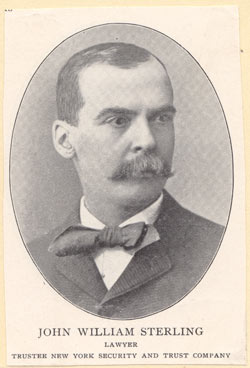
Failed Romance?
The biographer's reference to a possible ill-fated "youthful romance" (implicitly, with a woman) is an explanation employed by other chroniclers struggling to understand their subjects' contravention of social pressures to marry, and their long-term same-sex intimacies.
For example, a local historian, writing in 1894, about two women who lived together in Greene County, NY, in the early-19th-century, claims: "both of them, in their younger days, experienced a romance that had broken their hearts, and the bond of sorrow between them had drawn the two close to each other in womanly sympathy.[8]
At the end of the 19th century, the "failure" to marry was becoming an issue of increasing concern. Not marrying was becoming a newly suspect sign of gender impropriety. An earlier commentary on the same women, written about 1850, makes no attempt to explain their not marrying.[9]
Sterling's not marrying is also the subject of comment in two late-19th-century editions of his Yale class books. The 1891 edition notes simply that Sterling is "unmarried." But the 1895 edition states emphatically: Sterling "has never married" -- as if an exasperated editor had now given up any hope of Sterling ever tying the knot.[10]
Vanderlip's Memoir
A memoir of Sterling in the Saturday Evening Post in 1935, by financier Frank A. Vanderlip, speaks of attending a dinner party of elderly ladies and gentlemen in Sterling's Fifth Avenue "bachelor establishment." There, says Vanderlip, Sterling's "companion was a lifelong friend named Bloss--by his familiars called Blossy."
That nickname is telling. It is difficult, for example, to imagine John Sterling being called "Johnny" or "Sterl." Does Bloss's nickname suggest a certain effeminacy? Does "Blossy" tell us something about the "widely different tastes" of Sterling and Bloss, to which Garver refers?
Vanderlip, in retrospect, believes it would have been "fascinating" to have "tried to identify among those old ladies" at the dinner the one whose rejection "had turned Sterling into a bachelor." It does not occur to Vanderlip that Sterling's spousal equivalent was Blossy.[11]
Fears
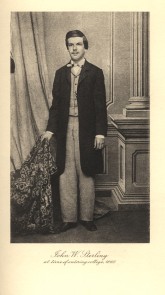
Gaining the world's respect was an important goal of Sterling's, his journal indicates. So his contravention of society's marital standard, and, perhaps, its sexual proprieties, would have been a profound source of conflict and anxiety. Garver's biography and Sterling's journal indicate that he was beset by numerous anxieties -- among them, about water travel.
As Garver puts it, from Sterling's father, a successful ship's captain, the son had "inherited" his business ability; "but it was undoubtedly to his mother that an anomalous trait of his character must be attributed, namely, his shrinking from all forms of transportation by water." Sterling displayed a "deep-rooted antipathy to the ocean," says Garver.[13]
Though writing in 1929, when Freud and psychological thinking were in ascendancy in American culture, Garver had no sense that Sterling's antipathy to an ocean/father and identification with an anxious mother's fear of water travel might provide insight into this bachelor's psyche.
A Woman's Intuition
Elsewhere, Garver contrasts the rigorously logical, analytical mind of Sterling's law partner, James Shearman, with Sterling's way of reaching conclusions by "vigorous practical common sense." Garver adds: Sterling's was "almost a woman's intuition."[14]
Again, Freudian analysis, and the 20th-century idea that gender deviance suggests sexual deviance did not disturb this lawyer's mind. Garver displays a consciousness more typical of the mid-19th-century, in which the almost fifty-year intimacy between Sterling and Bloss would have carried no implication of sexuality. Affection and sexuality were thought then to reside in separate spheres.
The Yale Bed-Mate
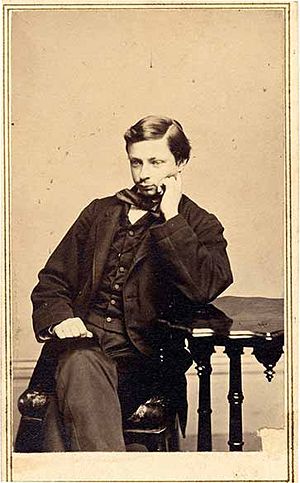
The same 19th-century distinction between affection and the sexual meant that young men friends could sleep together at Yale without anyone suspecting them of illicit erotic acts, whatever sometimes went on in those beds.[16]
For example, Sterling's journal for September-October 1862 records: "I slept with Jim Mitchell last night an." The "an" continuing the entry is crossed out by Sterling, as he stops himself from saying more, and adds a period to end the sentence and halt further inquiry.[17]
Sterling's bed partner, James Buchanan Mitchell (Yale 1863), received "preparatory training" in Stratford, Connecticut, Sterling's home town, and went on to Columbia Law School, as did Sterling, suggesting an ongoing relationship. Mitchell's remaining a life-long bachelor, like Sterling, seems, under the circumstances, more than coincidental.[18]
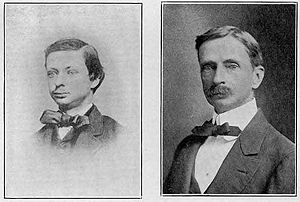
The Bachelor Subculture
Sterling, Bloss, and Mitchell were members of the increasingly prominent bachelor subculture of late19th-early 20th century America, to which Yale contributed some interesting examples. Mitchell's class of 1863 produced, in fact, another lifelong bachelor, John Safford Fiske, tried in London, in 1870, for participating in an international conspiracy to commit "buggery" -- the famous Boulton and Park case.[20]
Burglars In His Bedroom?
Garver notes in passing that Sterling's "disposition to protect himself" from unwanted visitors was shown "in his residence, where he devised special protection for his bedroom against possible burglars." An electric door lock or alarm, devised by Sterling, was controlled by a button by his bedside.[21]
Was Sterling really afraid of burglars in his bedroom? Or did he, perhaps, fear one of his servants stumbling upon him and Bloss in a compromising scene? Or did Sterling's alleged fear of burglars originate, more generally, with anxieties about his unconventional rejection of marriage, and long-term, live-in intimacy with Bloss?
Stokes' Memoir
The Rev. Anson Phelps Stokes, Yale's Secretary from 1899 to 1921, also remembered that Sterling "had one peculiarity," a "phobia" about burglars." In a note that Phelps suggested not be published while members of Sterling's immediate family were still living, Phelps recalled:
His housekeeper once told me that Mr. Sterling would not go to bed until she had looked under the bed to be sure that there were no burglars there, and I can remember her taking a stick and going through his closet in the way that he required to make sure that there was no one hidden there. He also had an iron door to his bedroom and iron bars in the window. A friend whose name I have forgotten for the moment, but he was a well known cotton broker [Bloss], slept in the same room with him, and his valet, who was a very strong man, in the room adjoining.[22]
Stokes suggests that Sterling and Bloss "slept in the same room" so that Sterling would feel protected, and this rationale seems designed to sooth any doubts Sterling himself might have had about about the propriety of a male bed partner.
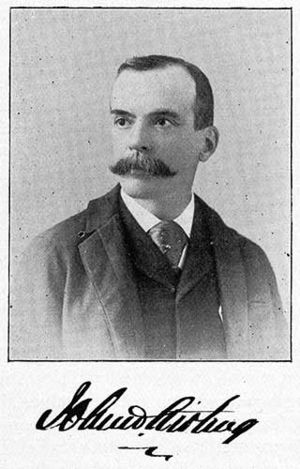
The Beecher Scandal: A Trial Of Intimacy
Garver stresses that Sterling, who hated and even dreaded publicity, nevertheless figured in several cases that made sensational newspaper headlines. Soon after Sterling became a partner with Thomas G. Shearman, the firm's first important case was the 1875 defense of America's most famous preacher, the Reverend Henry Ward Beecher. The clergyman's best friend,Theordore Tilton, had charged that the married Rev. Beecher had committed adultery with Tilton's wife, a Beecher parishoner.
When a jury could not agree about Beecher's guilt or innocence he was acquitted. Sterling's partner, says Garver, devoted himself "unsparingly" to the defense of Beecher, of "whose innocence he never entertained a shadow of a doubt."[24]
What Sterling thought of Beecher's behavior is unknown. But this public "trial of intimacy," as it has been called, inquired whether Beecher had been sexually intimate with Elizabeth Tilton, as well as affectionate.[25] This famous scandal publicly raised questions about the presence of sexuality in relationships earlier considered, simply, spiritual and loving, helping to create a new, American sex-consciousness. This led, in the early 20th-century, to widespread suspicions about eros in same-sex intimacies like that between Sterling and Bloss. The sex-consciousness constructed by the Beecher case probably gave Sterling new cause for anxiety.
The Sterling-Bloss intimacy was transitional. These men lived through two widely different era's of American sexual history -- the era of Victorian sex-retiscence, and the era of modern sex-talk.
Politics
As a lawyer and legal strategist for railroad magnates Jay Gould and James Fisk, and numerous other railroad owners, the National City Bank, and Standard Oil, Sterling actively promoted the early-20th-century consolidation of American big business, and the interests of those that radical and liberal "trust busters" called "Robber Barons." As a conservative, upper class man of his time, Sterling opposed social welfare measures now considered basic protections of working Americans. Sterling's retrograde politics interrupt any facile, romanticized attempt to claim him today as a positive role model for queerdom.
Love Affair With Yale
Because Sterling was without the usual marital, family, and emotional ties, says Garver, he directed his "devotion" to Yale, "and its delightful associations" (including, I suggest, bed-sharing).* Garver's point is that Yale benefited directly from Sterling's making his alma mater (not a wife or offspring), a major object of devotion.
When Sterling died on July 5, 1918, this corporation lawyer left Yale more than 15 million dollars (about 180 million today), the largest endowment, claims his biography, "ever given to an existing seat of learning."[26] Sterling's financial contribution to Yale was actually much greater, since he encouraged other large donations to the school.
Sterling's gift was used to build Yale's Law School, the Divinity School quadrangle, a School of Medicine, residential buildings (Trumball College), a hall of graduate studies, a chemistry laboratory, a tower for the Sheffield Scientific School, and Sterling Memorial Library. The endowment continues to support the awarding of Sterling Professorships, one of the highest, best-paying honors Yale conveys on its most accomplished professors.*
The Will
The first article of Sterling's will, in the Archives of Sterling Library, directs his executors to "burn up, without examining or opening, all books, papers, whether bound or unbound, and all packages or parcels, in my possession or under my control at the time of my decease, containing upon them directions, in my handwriting, that I desire or request the same to be destroyed or burned." Sterling perceived himself as a man with something to hide.
Sterling's will refers several times to his "friend" Bloss: It's second article says: "I give. . . to my friend, James O. Bloss, all papers, packages and parcels, containing upon them directions in my handwriting, that the same should be delivered to him upon my decease."
Sterling entrusted Bloss, and only Bloss, with some archival task. Did Sterling ask Bloss to destroy personal papers and letters that revealed details of their relationship? Sterling's later, detailed, personal journal seems to exist now only in an expurgated, typed copy, though his earlier, difficult-to-read, longhand journals remain to be investigated.*
A Memorial To Single-Blessedness
In the fourth article of Sterling's will, he directs: "no interment other than my own and that of my...sister, Cordelia, shall ever take place" in his Mausoleum in Woodlawn Cemetery. An exception is made, however, "in case my said friend, James O. Bloss, who has lived with me for more than forty years, should desire to be interred in the said Mausoleum and should die without ever having been married."
Sterling provided that Bloss could be buried in his Mausoleum only if he never married, thereby making Bloss's continued bachelorhood an essential requirement of his friend's post-death loyalty. Sterling also provided that only his unmarried sister, Cordelia, not his married sister Catherine, could be interred with him, thereby constructing his Mausoleum as a memorial to single-blessedness-- even, to marriage resistors.
Cordelia Sterling is burried with her brother. Bloss died less than six months after Sterling, and is not buried with his friend, though the reason is unknown.
Sterling's obituary in the New York Times referred to "his lifelong friend, James O. Bloss, a retired cotton broker, who made his home with the testator for more than forty years."[27] About Bloss, little is now known, and no photograph has yet been discovered.Research Request:
Heart to Heart Once More Are We
Garver's picture of Sterling as unromantic and businesslike, is belied by a few lines of a poem by the queer English writer Charles Algernon Swinburne, clipped by Sterling from the New York Times in 1883. The lines are pasted into his Commonplace Book, unlike any of the book's many other mechanically reproducced entries. Almost hidden away on the very last page of that book, the lines' placement gives them a unique, summary position:
"Once more I give me body and soul to thee, Who hast my soul for ever: cliff and sand Recede, and heart to heart once more are we."[28]
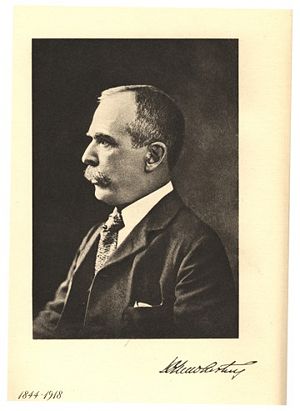
A Final Note
James Orville Bloss died suddenly in New York City, only five months after Sterling, on December 15, 1918. A few days after Bloss's death, a correspondent named Holland commented in the Wall Street Journal that many of the published reports" of his death referred
to the unusual, almost unique, friendship that characterized the relation long established between John W. Sterling and Mr. Bloss. Both were bachelors, both were of far more than local reputations, Mr. Sterling being esteemed as one of the ablest of New York lawyers, and Mr. Bloss highly regarded among the world bankers.
Sterling, the comment continued, "was almost taciturn, and excessively devoted to his profession. He sat before his desk every morning, not later than eight o'clock, and was usually the last one in the office to close the desk and go home."
In contrast, said the correspondent, Bloss "was very companionable, temperamentally very different from Mr. Sterling." The reporter stressed: "This unusual relation. . .was often spoken of and commented upon. . . ."[30]
Author's Note
This article was first included on April 2, 2003, on a website for which Carl Pritzkat of Mediapolis provided the software, engineering, and web hosting, for which I am deeply grateful. For research assistance on this article I am grateful to William Massa, Manuscripts and Archives, Sterling Memorial Library, Yale University, who alerted me to rumors of Sterling's long intimacy with Bloss. I also thank Bill McGovern, the staff of the Stratford Historical Society, and note the contribution of the late Joel Honig. Copyright (c) by Jonathan Ned Katz. Not to be reproduced for commercial purposes without permission.
References
- ↑ John Anson Garver, John William Sterling: Class of 1864 Yale College, A Biographical Sketch (New Haven: Yale Univerity, 1929), opposite p. 6.
- ↑ On Sterling's admission to the bar in 1867: Garver, p. 24; Sterling never marrying, Garver, p. 73. Sterling's journal of October 2, 1872 (in the Yale University Manuscripts and Archives), notes that Bloss is coming to Sterling's boarding house, to stay in an upstairs room. An entry of May 4, 1873, says "Bloss and I are busy house hunting and have arranged to go to 21 West 25th Street." I thank Joel Honig for that research.
- ↑ Garver, p. 73. In 1890, the U.S. Cenus shows Sterling and Bloss living together at 221 East 47th Street, with an African American butler and houskeeper, and two white servants (U.S. Census, 1900, ED 744, p. 1). They moved in 1902 to 912 Fifth Avenue, a mansion commissioned by Sterling and designed by society architect Bruce Price. I thank Joel Honig for that research.
- ↑ Garver, 90.
- ↑ Yale University Manuscripts and Archives Digital Image Collection, Image 698.
- ↑ Garver 105.
- ↑ add source
- ↑ Jonathan Ned Katz, "Miss Willson and Miss Brundage: A Romantic Attachment to Each Other." The Advocate, Research Request: DATE? YEAR?, 45-46
- ↑ Katz, "Miss Willson and Miss Brundage, 45-46, citing R. Lionel De Lisser, Picturesque Catskills (1894) and "An Admirer of Art" (c. 1850).
- ↑ Class of 1864 Yale College (1891), 20. See also: History of the Class of 1864, Yale College (Princeton: C. S. Robinson., University Printers, 1895), 130-31.
- ↑ Frank A. Vanderlip, TITLE MISSING, Saturday Evening Post, DATE, 1935, PP MISSING
- ↑ source?
- ↑ Garver, pp. 2-3.
- ↑ Garver, 65
- ↑ Carte-de-visite photo by Prescott & Gage, Hartford, CT; from album originally owned by Selah Merrill. Yale University, Manuscripts & Archives, image 6078; call no. Y671 863m
- ↑ Jonathan Ned Katz, Love Stories: Sex Between Men Before Homosexuality (Chicago: University of Chicago Press, 2001), see chapter on Albert Dodd.
- ↑ Sterling's Journal is in the Manuscripts and Archives Division of Yale University's Sterling Memorial Library.
- ↑ On Mitchell see: Triennial Meeting and Biographical Record of the Class of Sixty Three in Yale College (1869), 71-72. See also: Second Report of the Class of Sixty-Three of Yale College (1878), 54; History of the Class of 1863 (1889), 87-88; History of the Class of 1863 Yale College (1905), two photos of Mitchell, 122; biography of Mitchell 124-27; Yale University, Obituary Record of Graduates Deceased During the Year Engind July 1, 1924 (1924), 1003-1004.
- ↑ History of the Class of 1863 Yale College (1905), two photos of Mitchell, 122
- ↑ Jonathan Ned Katz, Love Stories, see chapter 13, on John Safford Fiske, "A Heart Full of Love and Longing," 188-201.
- ↑ Garver, 100.
- ↑ Anson Phelps Stokes, memoir of Sterling, in Yale University Manuscripts and Archives.
- ↑ History Class of 1864 [1895], p. 130.
- ↑ Garver 76.
- ↑ See: Richard Wightman Fox, Trials of Intimacy: Love and Loss in the Beecher-Tilton Scandal (Chicago: University of Chicago Press, 1999).
- ↑ Garver, p. 105.
- ↑ "$15,000,000 Sterling Bequest to Yale." New York Times, July 17, 1918, p. ?, col. ?.
- ↑ Research Request:MISSING note on Swinburne>
- ↑ Garver, opp. title p.
- ↑ Holland, comment on Bloss and Sterling, Wall Street Journal, December 21,1918, p.2).
External links
Wikipedia: John_William_Sterling
Categories
- Bloss, James O. (1847-1918)
- Columbia Law School alumni
- Connecticut
- Fiske, John Safford (1838-1907)
- New York City
- Research Requests
- Sterling, John W. (1844-1918)
- Yale University
- Yale University alumni
- 20th century
- 19th century
- 1870-1879
- 1880-1889
- 1890-1899
- 1900-1909
- 1910-1919
- 1844 births
- 1847 births
- 1907 deaths
- 1918 deaths